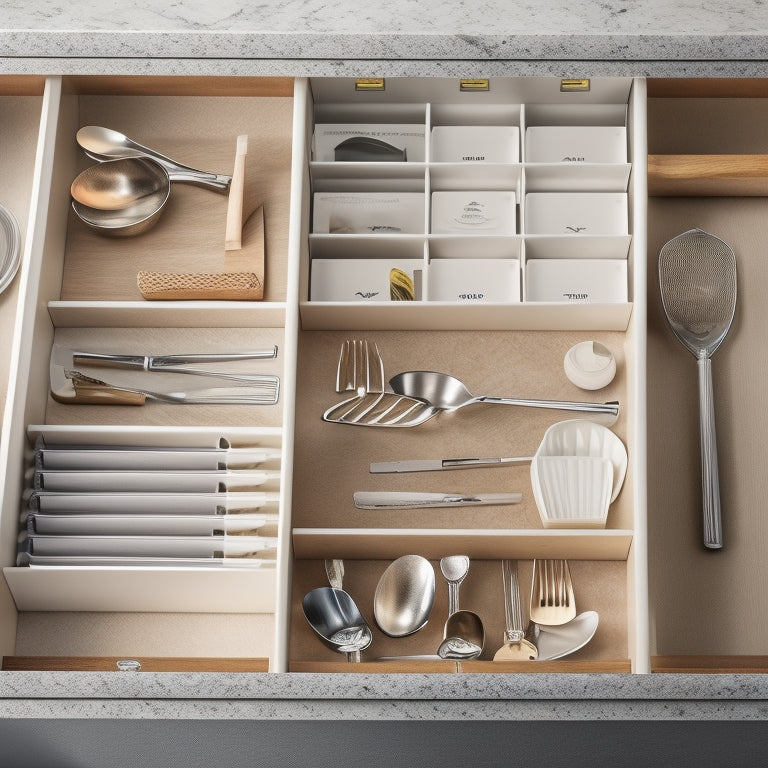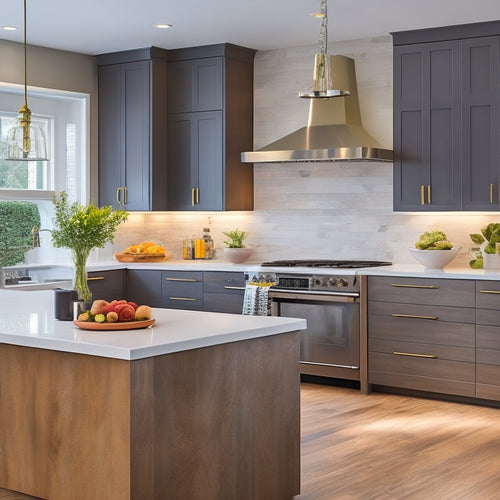
7 Essential Kitchen Drawer Organization Hacks
Share
You're tired of digging through cluttered kitchen drawers, only to find the utensil you need stuck in a tangled mess of others. To bring order to the chaos, start by purging and categorizing your utensils, assigning a home for each item, and utilizing vertical storage spaces. Implement a drawer divider system to corral clutter, store heavy items at the bottom, and designate a junk drawer for miscellaneous items. Finally, maintain a regular cleaning schedule to keep your drawers organized. With these essential hacks, you'll be well on your way to a stress-free cooking experience - and there's more to discover to maximize your kitchen's potential.
Key Takeaways
• Purge and categorize kitchen utensils by separating essentials from duplicates, broken items, and never-used gadgets to declutter efficiently.
• Assign a home for each item, utilizing a labeling system, frequency of use, and color coding to create a system that works for you.
• Maximize hidden vertical space in kitchen drawers by using hooks, stackable containers, and baskets to free up room for essential items.
• Implement a drawer divider system to segment the drawer into distinct zones, corral clutter, and create a sense of order.
• Store heavy items at the bottom of the drawer to ensure proper weight distribution and reduce the risk of items falling out.
Purge and Categorize Kitchen Utensils
As you begin the mission to tame the chaos in your kitchen drawers, start by taking everything out and giving your utensils a ruthless once-over, separating the essentials from the duplicates, broken items, and never-used gadgets that are simply collecting dust. This is your chance to declutter efficiently, getting rid of anything that's no longer serving a purpose. Be honest with yourself - if you haven't used it in the past year, you probably won't miss it.
Next, categorize your remaining utensils effectively by grouping similar items together. This will make it easy to see what you have and where it should go. For example, group all your baking utensils together, followed by your cooking utensils, and so on. This step is pivotal in creating a system that works for you, not against you. By categorizing your utensils, you'll be able to see what you need, what you can get rid of, and what you can replace.
With a clear picture of what you're working with, you'll be well on your way to creating a kitchen drawer organization system that truly empowers you.
Assign a Home for Each Item
Now that you've purged and categorized your kitchen utensils, it's time to give each item a designated spot, making it easy to find what you need when you need it. This is where a labeling system comes in handy. Use labels or stickers to identify what's inside each organizing container, so you can quickly scan and grab what you need.
When assigning a home for each item, consider the frequency of use and the layout of your drawer. Place your most-used items in easy-to-reach locations, and group similar items together. For instance, store all your baking utensils in one container, and your cooking utensils in another.
To take it a step further, consider color coding your containers or labels to differentiate between categories. This visual cue will help you find what you need even faster.
Utilize Vertical Storage Spaces
Your kitchen drawers have a hidden treasure: the often-wasted vertical space between the top of the container and the drawer's ceiling, which can be leveraged to store less frequently used items or bulky kitchen tools.
By maximizing this space, you can free up room for more essential items and reduce clutter.
One effective way to do this is by utilizing hooks. You can install hooks on the ceiling of your drawer or on the side of a container to hang items like utensils, oven mitts, or even a kitchen scale. This not only saves space but also keeps these items within easy reach.
Another option is to use stackable containers or baskets that can be placed on top of each other, allowing you to store more items in a smaller footprint.
Implement a Drawer Divider System
By segmenting your drawer into distinct zones using a divider system, you can corral clutter, assign a home to each item, and create a sense of order that makes finding what you need a snap. This is especially effective in kitchens where utensils, gadgets, and cookware can quickly overwhelm the space.
With a divider system, you can maximize space by allocating specific areas for specific items, ensuring that everything has its designated spot. This allows you to customize the layout to fit your unique needs and workflow. For instance, you can designate a zone for sharp objects, another for cooking utensils, and a third for baking supplies.
Store Heavy Items at Bottom
To maintain your kitchen drawer remains organized and functional, place your heaviest items, like cast-iron skillets or large serving dishes, at the bottom of the drawer, where they're less likely to topple over or cause a mess. This bottom heavy storage approach ensures proper drawer weight distribution, preventing the drawer from becoming unbalanced and difficult to open. By storing your heaviest items at the bottom, you'll also reduce the risk of them falling out when you open the drawer, making it safer and more convenient.
Additionally, storing heavy items at the bottom creates a solid foundation for the rest of your kitchen essentials. You can then arrange your lighter items, such as utensils, cookware, and gadgets, in an organized and accessible way. This strategic approach to kitchen drawer organization will make your cooking and food preparation tasks more efficient and enjoyable.
Designate a Junk Drawer
Set aside a single drawer as a catch-all for miscellaneous items that don't have a designated home, like twist ties, spare batteries, and takeout menus, and label it your 'junk drawer' for easy identification. This designated space will help keep your kitchen organized and clutter-free. By containing the chaos, you'll be able to find what you need quickly and easily. When you label junk, you're acknowledging that it's not going anywhere, but you're also taking control of it.
To organize efficiently, consider dividing the drawer into smaller compartments or using small containers to separate items. This will prevent the junk drawer from becoming a black hole where things get lost. You can also set a rule for yourself to clean out the junk drawer every few months to get rid of items that are no longer useful or expired.
Maintain a Regular Cleaning Schedule
You'll find it's much simpler to keep your kitchen drawers organized when you establish a consistent cleaning schedule, allowing you to tackle clutter before it accumulates and overwhelms your newly designated junk drawer.
Set aside a specific day and time each week to maintain your kitchen's tidiness. Create a cleaning checklist to make certain you don't miss a single spot, from wiping down countertops to dusting those hard-to-reach shelves.
Make it a habit by incorporating it into your daily routine, like right after breakfast or before dinner. To stay motivated, establish a reward system. Give yourself a treat or some downtime after completing your cleaning tasks. This will help you stay committed to your schedule and make the process more enjoyable.
By maintaining a consistent cleaning schedule, you'll be able to enjoy your organized kitchen drawers for the long haul, without the stress of clutter creeping back in.
Stay on top of your kitchen's cleanliness, and you'll be cooking up a storm in no time!
Frequently Asked Questions
How Do I Organize Kitchen Drawers With Odd-Shaped Utensils?
"When organizing kitchen drawers with odd-shaped utensils, you'll want to create custom drawer inserts that cradle each piece, and utilize vertical storage solutions to maximize space, keeping your kitchen tidy and efficient!"
Can I Use Adhesive Hooks in My Kitchen Drawers?
You can definitely use adhesive hooks in your kitchen drawers to maximize storage, but consider combining them with drawer liners and custom compartments for a tailored fit that keeps your utensils organized and within easy reach.
Are There Alternatives to Traditional Drawer Dividers?
You're wondering if there's more to drawer organization than traditional dividers? Absolutely! You can create DIY solutions with custom organization systems, and think outside the box with upcycled containers and creative layouts that reflect your personal style.
How Often Should I Reorganize My Kitchen Drawers?
You should reorganize your kitchen drawers every 3-6 months to maintain efficiency and decluttering benefits, weighing frequency against disadvantages like wasted time; use methods like categorizing, purging, and assigning homes to optimize your space.
Can I Organize My Kitchen Drawers Without Buying New Products?
You can definitely organize your kitchen drawers without breaking the bank! Try DIY organization by repurposing containers, utilizing vertical space, and mastering decluttering techniques to maximize storage and minimize mess.
Related Posts
-

Why Cluttered Spaces Hold You Back From Productivity
You're struggling to get things done amidst the chaos of your cluttered space. It's not just a physical mess - it's m...
-

Streamline Your Small Bathroom With These Systems
You can reveal your small bathroom's hidden potential by implementing a few strategic systems that maximize every inc...
-

Smart U-Shaped Kitchen Remodeling Solutions
You're undertaking a smart U-shaped kitchen remodeling project, and optimizing space efficiency is key to creating a ...


